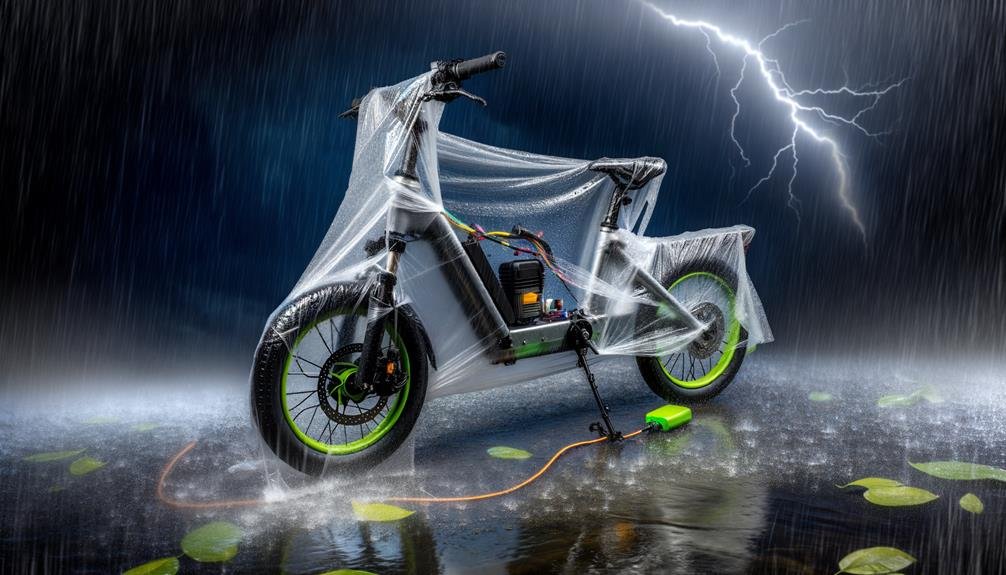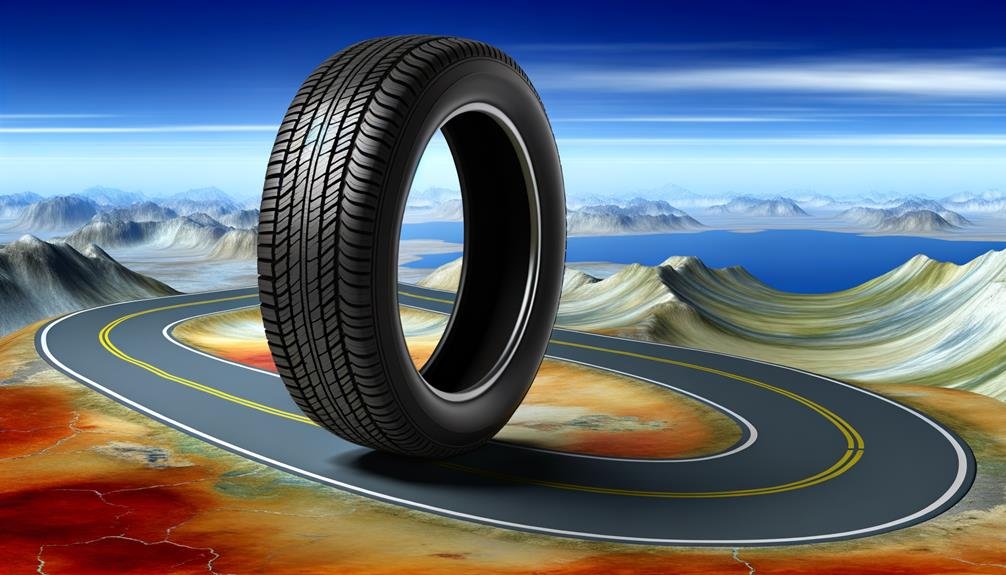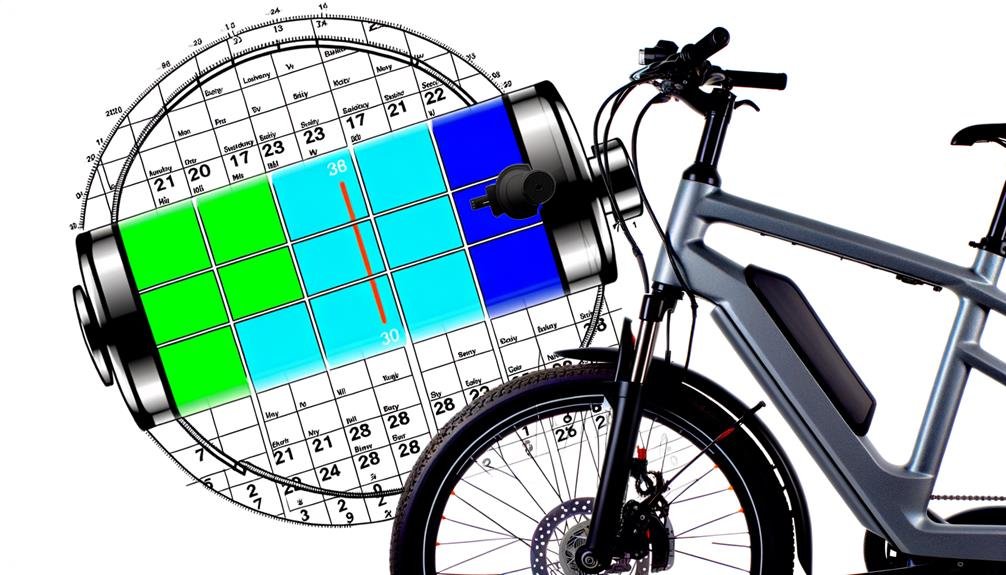Charles Miller is a veteran bike enthusiast with over 12 years of experience dealing with bikes as a mechanic. Despite immense love and expertise for...
Just like a ship's captain battening down hatches to prepare for a storm, you need to waterproof your electric bike to protect it from potential water damage.
Weather can be unpredictable, and getting caught in a rainstorm while on your e-bike can lead to serious damage to its electrical components if not adequately protected.
Now you're probably wondering, 'How exactly do I waterproof my electric bike?'
Buckle up, because we're about to embark on a journey to unravel the various techniques, materials, and steps you can take to safeguard your e-bike against the elements. But beware, it's not as simple as just slapping on a raincoat.
Key Takeaways
- Proper waterproofing is essential to protect the electrical components of an electric bike from damage caused by weather.
- Meticulous attention to detail and proper wire installation techniques are necessary for effective waterproofing.
- Sealants, self-fusing silicone tape, ACF50 spray, and heat shrink insulation can enhance water resistance.
- The battery requires specific techniques such as waterproofing spray, potting with epoxy, and heat shrink insulation for effective waterproofing.
Understanding E-Bike Water Resistance
To keep your e-bike running smoothly during wet weather conditions, it's vital to understand the importance of water resistance and how to effectively waterproof your bike's electronic components. Your e-bike's performance is significantly influenced by how well its motor internals, controller, wiring, display unit, throttles, and batteries are protected from water ingress.
Waterproofing your e-bike is no small task. It necessitates meticulous attention to detail and the application of proper wire installation techniques. Recommended sealants and alternative sealing methods, such as self-fusing silicone tape, can enhance the water resistance of your e-bike's components.
Using sprays like ACF50 can provide additional protection, creating a waterproof barrier to ward off moisture. For electrical components, consider heat shrink insulation. This technique not only waterproofs the components but also provides a snug fit, reducing the chances of loose connections.
Waterproofing E-Bike's Battery
Let's move on to your e-bike's battery, which requires specific techniques for effective waterproofing.
You'll need to consider both the selection of waterproof covers and the application of certain materials for optimal protection.
Regular preventive maintenance is also a crucial part of ensuring your battery's longevity and performance.
Battery Protection Techniques
When waterproofing your e-bike's battery, it's essential to seal the battery compartment to block any water ingress and potential damage. This is a crucial part of your ebike repair routine.
Here are some battery protection techniques you can use:
- Use a waterproofing spray or sealant on the battery, much like you'd with a car battery. This makes your battery water-resistant.
- Potting the battery is an option for extreme waterproofing. This involves encasing the battery in a substance like epoxy to provide a moisture barrier.
- Heat shrink insulation protects your battery connections. Ensure all cable connections to the battery are properly sealed.
Selecting Waterproof Covers
Beyond sealing and insulating your e-bike's battery, you should also consider the use of waterproof covers for added protection. When selecting waterproof covers, choose one specifically designed for your e-bike's battery to ensure a snug fit.
It's important to keep water out, so look for covers made from durable, waterproof materials like nylon or PVC. Secure closures, such as zippers or velcro, are essential to prevent water from seeping in.
To waterproof your electric bike effectively, consider covers that offer UV protection, keeping your battery both covered and filled with life.
Lastly, prioritize covers that are easy to install and remove for convenient access to the battery while preserving its waterproofing.
Preventive Maintenance Tips
To ensure your e-bike's battery stays dry and fully functional, it's crucial to perform regular preventive maintenance that includes several waterproofing techniques. If your e-bike is often exposed to rain, these preventive maintenance tips are essential.
- First, seal exposed battery connections with shrinking tubes and silicone. This is a decisive step towards waterproofing your e-bike.
- Next, consider applying liquid tape and dielectric grease to the hall throttle. This will offer added protection against water damage.
- Lastly, it's worth opening up the hub motor, adding statorade for cooling, and sealing openings.
Protecting the Motor
In safeguarding your e-bike's motor, it's crucial to seal exposed electronics like the battery and adaptto to ward off potential water damage. It's about protecting the motor from harm, ensuring your electric bike's longevity and efficiency.
Consider this table for guidance:
| Task | Material |
|---|---|
| Sealing Connections | Shrinking Tubes, Silicone |
| Controller Seal | Liquid Tape |
| Redoing Connectors | Dielectric Grease, Heat Shrink |
| Hub Motor Seal | Statorade |
Ensure cable connections are tightly sealed using shrinking tubes and silicone. The adaptto, or controller, needs proper sealing too. Redoing connectors with liquid tape, dielectric grease, and heat shrink adds an extra layer of protection. Don't forget to open the hub motor, add statorade for cooling, and seal it tight to avoid water ingress.
Safeguarding Electronic Components

Now, let's focus on safeguarding the electronic components of your electric bike.
You'll want to pay special attention to protecting the battery pack, shielding the controller unit, and ensuring the motor's water resistance.
Each of these steps is crucial in effectively waterproofing your e-bike and maintaining its performance in any weather condition.
Protecting the Battery Pack
When waterproofing your electric bike, it's vital to seal the battery pack and electronic components effectively to ward off potential water damage. Protecting the battery pack is key to keeping your e-bike running smoothly, even in wet conditions. It's about creating the most extreme waterproofing possible to ensure longevity and optimal performance.
Here are some tips to get you started:
- Use heat shrink tubes and silicone to seal cable connections, preventing water ingress.
- Apply liquid tape, dielectric grease, and heat shrink on connectors for an extra layer of protection.
- Consider spraying a waterproofing liquid directly onto the battery for a comprehensive guard.
With these measures in place, your electric bike's battery pack will be well-protected and ready for any weather conditions.
Shielding the Controller Unit
Just as crucial as protecting your battery pack is properly sealing your e-bike's controller unit to shield it from potential water damage. You can redo connectors using liquid tape, dielectric grease, and heat shrink for comprehensive protection.
Mount the controller vertically and make sure to seal the top cap, thus preventing water ingress. An electronics-safe spray to make your controller waterproof is a wise addition, as is considering wire placement for additional safeguarding.
For extreme waterproofing, you can use potting, a method that effectively shields the controller unit and other electronic components.
With these steps, your electric bike's heart and soul—the controller unit—will be well shielded from the elements, extending its lifespan and performance.
Ensuring Motor's Water Resistance
To ensure your e-bike's motor resistance to water and safeguard its electronic components, start by sealing exposed electronics like the battery and controller. As part of your process to waterproof your electric bike, use shrinking tubes and silicone to seal cable connections, ensuring motor's water resistance against water ingress.
To grab your attention, here are a few essential steps:
- Properly seal the controller. This step is crucial in ensuring the waterproof quality of your electric bike.
- Protect motor, controller, wiring, display unit, throttles, and batteries from water ingress using appropriate sealing methods.
- Consider using electronics-safe spray or ACF50 spray to make the electronic components water-resistant.
In doing so, you're not just waterproofing your e-bike, but also prolonging its lifespan and enhancing its performance.
Utilizing Waterproofing Sprays and Tapes

Kick-start your e-bike's defense against water damage by utilizing waterproofing sprays and tapes. These are powerful tools you can use to protect the wiring and electronics of your electric bike.
Waterproofing sprays, such as ACF50, are excellent for making your e-bike's electronics water-resistant. When properly applied, this can provide up to two years of protection against water damage. Take care to apply the spray evenly, ensuring it reaches all the nooks and crannies of your e-bike's electronic components.
Silicone self-fusing tape is another tool in your arsenal. It's perfect for shielding exposed wires from the rain and any water that might splash up during your ride. Just wrap it tightly around any exposed wires, and you'll have an effective barrier against water.
Marine-grade, heat shrink insulation is an affordable solution for waterproofing your essential electrical wiring. It's easy to use and highly effective, offering another layer of protection for your electric bike.
Choosing a Waterproof E-Bike
If you're keen on safeguarding your e-bike's longevity and performance, considering a fully waterproof model could be a game-changer. Choosing a waterproof e-bike ensures functionality in various weather conditions, including rainy and winter seasons, giving you the freedom to ride anytime you want.
A waterproof e-bike offers several advantages:
- Protects the electronics and components from water damage, extending the lifespan and maintaining the performance of your electric bike.
- Eliminates the need to consider alternative options like Zero motorcycles, as a waterproof e-bike provides all-weather functionality.
- Saves you from the hassle of dealing with water-related issues, giving you more time to enjoy your rides.
Frequently Asked Questions
How Do I Protect My E-Bike From Rain?
To protect your e-bike from rain, use rain covers, apply protective coatings, and invest in weatherproof accessories. When not in use, store it in dry, covered locations. Proper care ensures longevity and performance.
Will My Ebike Be OK in the Rain?
Yes, your e-bike can withstand rain, but its longevity depends on maintenance and using weatherproof accessories. Rain effects can impact e-bike durability, so regular check-ups and protective measures are essential for your ride's lifespan.
How Do I Make My Bike Water Proof?
To waterproof your bike, you'll use sealing techniques like silicone and shrink tubes. Waterproofing products, like dielectric grease and liquid tape, offer DIY solutions. Regular maintenance tips also ensure your bike's resilience against water damage.
Can I Hose Down My Electric Bike?
While you might be tempted, don't hose down your electric bike! This could cause water damage. Instead, adopt safe cleaning techniques, follow maintenance tips, and implement damage prevention strategies to keep your bike in top shape.
Conclusion
In conclusion, waterproofing your e-bike is as crucial as oiling a machine. With a few simple steps, you can seal it up tighter than a submarine.
Remember to protect the batteries, motor, and electronics, use waterproof sprays and tapes, and consider the benefits of a waterproof e-bike.
Don't let a little rain put the brakes on your ride. Take these precautions and you'll be unstoppable, powering through downpours like an all-weather warrior on two wheels!

Charles Miller is a veteran bike enthusiast with over 12 years of experience dealing with bikes as a mechanic. Despite immense love and expertise for his Tacoma, he rides his Trek Ebike more. Anytime you meet him, you’ll either hear him talking about Bikes, or writing about all things bikes and cars on this blog.
More Posts


